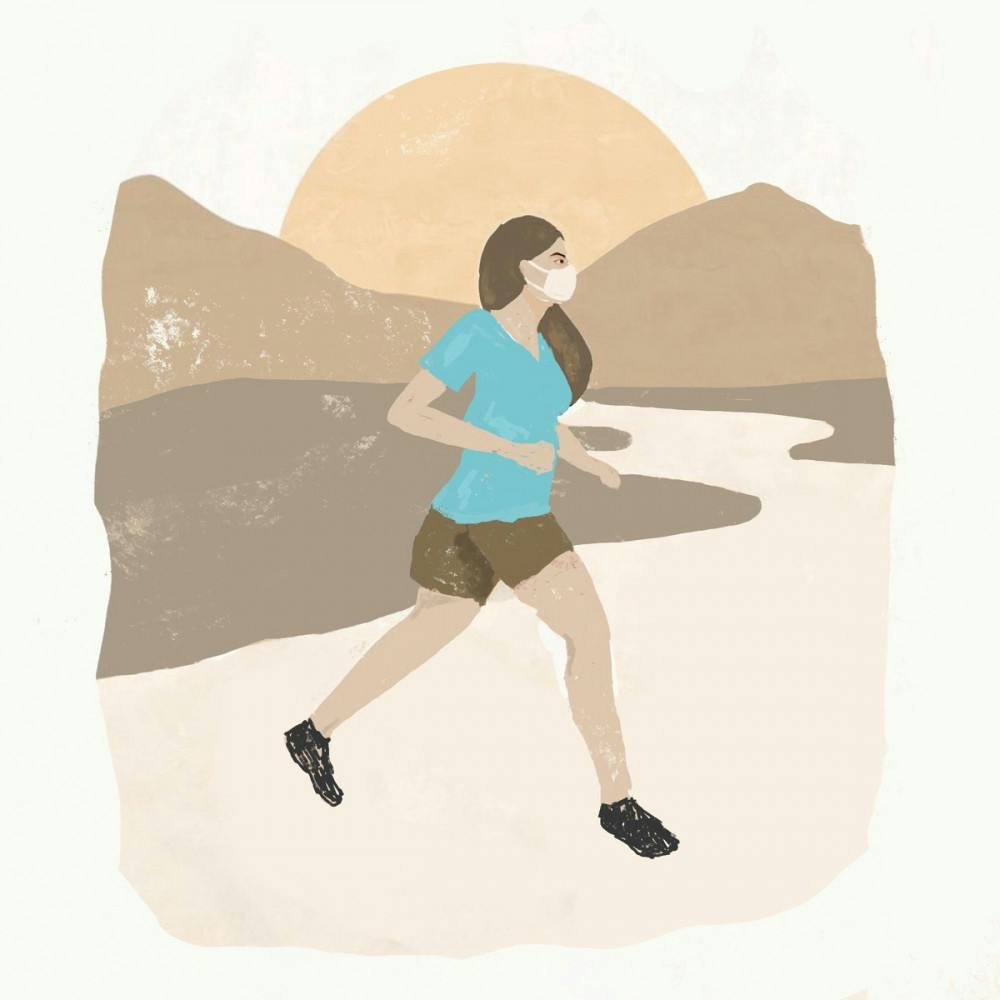When the University shuttered its doors in March along with gyms and recreational facilities across the country due to the coronavirus pandemic, many students found themselves forced to adapt how they work out and reflect on the significance of their exercise.
Before the Jonathan Nelson ‘77 Fitness Center closed, Jon Mallen ’22 held himself to a strict four-day rotating workout routine that targeted specific muscle groups. When Mallen was sent home to Redondo Beach, California, the lack of gym access made it more difficult for him to keep up his workout regiment.
But “even though I didn’t have a gym, I’ve found ways to stay active,” he said. While he was home, Mallen often went to a fitness park near his house, where he continued doing calisthenics on the rings, bars and platforms it offered.
Nicole Lim ’22 also has seen her workout routine altered by the pandemic. A member of the women’s club tennis team, Lim said that after the pandemic disrupted the team’s weekly workouts, she no longer had a regular exercise commitment.
Since then, Lim, who is studying remotely this semester, has found that she has been working out more consistently by going on runs and doing virtual floor workouts from Peloton and YouTube. She has even led some video workouts over Zoom with the tennis team.
“My routine now is better than what it was at school, and I am hoping that will continue when I go back,” Lim said.
Other students interviewed by The Herald have found it difficult to maintain their prior levels of physical fitness during quarantine.
Maura Driscoll ’22 was training for the Providence Half Marathon until the pandemic hit. She ran nearly every day with the Brown Running Club, and did additional workouts by herself to supplement her training. After the pandemic canceled the marathon and sent Driscoll home, she stopped training, “which was kind of fun, but it is always nice to have something to train for,” she said. “Not having the specific time every day where we can all meet has also been tough.”
Caitlin Takeda ’20 MS, who used to go to the Nelson four to five days per week, said that she has lost a lot of muscle mass, “and that’s been frustrating.” She added that she’s also no longer playing Gendo Taiko, a form of Japanese percussion, “which was a lot of exercise. And I’m not walking places anymore since I’m just doing classes on Zoom, so it’s all these factors where I’m not moving as much.”
Takeda tried virtual yoga and pilates, but she “found it really hard to do home workouts and keep myself motivated.” She ended up joining CORE Cycle Studios in Wayland Square. “It’s annoying to pay money to work out, but I also know I need some sort of delineation between home and working out,” she said.
Lamel Moore, executive director of the East Side/Mount Hope YMCA, said that he has noticed a small increase in membership among college students as the Nelson remains closed. “More and more athletes (have) taken use of our facility,” he said, including members of the women’s and men’s swimming team and women’s fencing team.
The pandemic “has put such a strain on people’s mental health and physical health,” Moore said. “If the YMCA can (help relieve that strain) while, unfortunately, the Brown facilities are closed, we’re here to help.”

Despite having returned to working out at a gym, Takeda said she is still “wary” of the risks of contracting and spreading the coronavirus. She usually selects the spin bike furthest from others in the class, and she noted that CORE Cycle Studios has separated bikes 12 feet apart and installed plastic shields between them.
But “if Providence’s numbers were to keep going up,” she said, “I would definitely reconsider going to spin.”
Moore said he recognizes that not everyone is fully comfortable returning to recreational facilities, but notes that gyms such as the YMCA have taken many precautions to prevent the spread of COVID-19.
All equipment is sanitized twice per hour, and members must make reservations online to use any fitness equipment and the pool, which helps the gym keep records for contact tracing and prevents overcrowding, Moore said.
Mallen has also considered purchasing a gym membership while the Nelson is closed. Mallen has relocated his calisthenics workouts from California to the Brown Street Park in Providence, but said he needs access to a bench press, dumbbells and pre-loaded barbells. “Those are essential for a lot of my workouts,” he said, adding that the “last few months have been a lot of improvisation.”
The pandemic has forced many students like Mallen to reimagine their workouts, and in doing so, reflect on what their workouts mean to them.
“It was difficult for me to figure out how to be active (during the pandemic), especially because soccer was not an option,” said Kiley Kellum ’21, a two-year captain of the women’s club soccer team. “It was kind of difficult post-COVID going from always exercising with teammates … to trying to initiate (exercise) by myself.”
Kellum and her roommates ended up joining CRG Warwick, a local rock climbing gym where she now climbs three to four times a week. “Most of what I’ve gained from soccer … was the social interactions I benefited from being on a team,” she said. Climbing “has reintroduced another social element that I’ve really enjoyed.”
Prior to the pandemic, Brown Running Club member George Daccache ’21 said that running for him was “more of an auxiliary thing if I had time after studying and finishing all the other things that I had to do.” But since the pandemic, he has started “looking at (running) in a new light.”
“Running is accessible, and having the benefit of staying in the same location, it’s familiar to me,” Daccache said. “It provides a sense of repetition. And it also gives me an excuse to go outside.” He added that he used to run for the physical exercise, but now does it for the mental health benefits, as well.
But Daccache also misses the social element of the Brown Running Club. “I always had a group of amazing people to run with,” he said.
“Not having the ability to have social events outside of practice keeps us more disconnected,” Brown Running Club member Driscoll said. “Sometimes I’ll meet with one or two other people, wear masks and run, but it’s nothing like running with big groups of people like pre-COVID.”
Many students are simply anxious for the return of organized athletics and gym access at Brown.
“I’m definitely looking forward to getting back to playing lacrosse, getting back to playing a team sport,” said Thomas Wilson ’22, a member of the men’s club lacrosse team. “I am excited to be physically active with a group of people who share a sport with me.”
“Over time I’ve been able to find ways to adapt,” Kellum said, “but I am looking forward to things returning back to normal or in some way being able to socialize with more people in a safe way.”

ADVERTISEMENT




